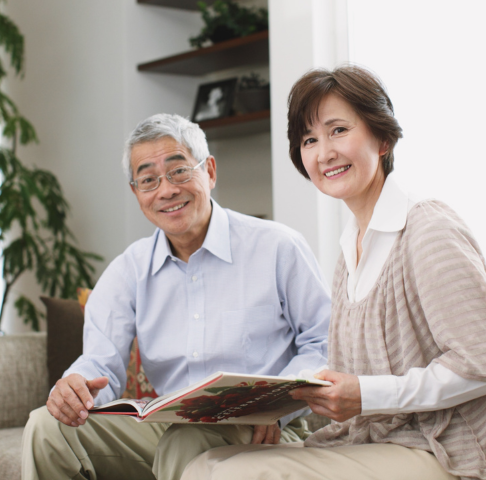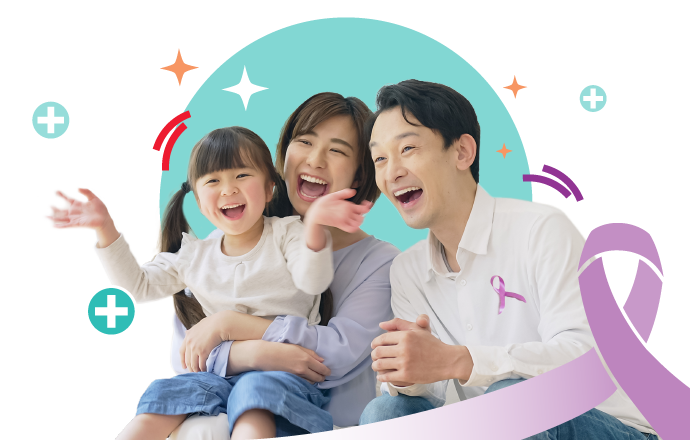A Singlife Shield Internal Survey done in 2022 found that 65% of all survey respondents with an Integrated Shield Plan were concerned about the risk of cancer. This could have something to do with the fact that cancer is the leading cause of death in Singapore. According to cancer statistics from the Ministry of Health, cancer accounted for 26.4% of deaths in 2021 – that’s about one in four deaths. With an average of 44 people being diagnosed with cancer daily, our biggest weapon against this disease could be knowledge.
While there’s plenty of cancer information to be gleaned from scientific journals – from cancer symptoms to cancer survival rates and cancer treatment side effects, there’s also much to learn from individuals who’ve lived with cancer. Here are some lessons we’ve drawn from the stories of cancer survivors that could help you ride through life’s stormy days or prepare better for them…
Lee Wei Sheng
By age 30, Wei Sheng had ticked off several milestones: his career in wealth management had taken off, he was married and had just become a father. When he experienced blurry vision, he put it down to an eye infection – until the condition worsened and began making everyday tasks like driving and carrying his daughter a challenge. The next thing he knew was that he had a pituitary tumour – a form of brain cancer. The blurry vision was a sign of cancer.
Here’s what we can learn from Wei Sheng’s cancer survivor story…
#1 Cancer doesn’t target specific groups, like old or physically weak people.
“I exercised several times a week, didn’t smoke, seldom drank and was never a night owl. In my free time, I’d indulge in hobbies like playing soccer and singing. After I was diagnosed, I was filled with disbelief and worry. I kept thinking, ‘How could this be happening to me when I’m only 30 and don’t lead an unhealthy lifestyle? Plus, my daughter is only a year old. What will happen to my young family and elderly parents if I don’t get through this?’”
#2 Living with a critical illness can be lonely – checking on someone ill and their caregivers can mean a lot to them.
Cancer treatment is hard on the body and mind. Dealing with the illness at the height of the Covid-19 pandemic made it tougher for Wei Sheng and his family. However, the support he received throughout the journey kept him strong.
“My wife had to shuttle between our home and the hospital daily to speak with different doctors. Then she’d update my parents back home and reassure them. On top of that, she had to ensure the safety and wellbeing of our daughter Jovie during the pandemic and attend to her clients’ needs at work.”
His family members helped to babysit Jovie while Emerlyn’s parents supported her wherever they could. Friends pitched in too, offering to keep Emerlyn company during his surgery and visiting him in hospital.
#3 Being forced to shift your priorities around because life throws you a curveball might not be a bad thing.
“I’ve been given a second chance to live and I want to make every moment count. I treasure life even more and constantly remind myself to be thankful, especially for my wife, family and friends. I now see challenges as opportunities, and I’m thankful that I made it through the greatest challenge in my life.
“I had cancer at 30 and I think we shouldn’t take our health for granted. My experience has made me an even bigger advocate of financial protection against unexpected situations like severe critical illness and accidents,” says Wei Sheng.
While medical debts can severely affect one’s quality of life, Wei Sheng is thankful he didn’t have to worry about his family’s finances and could focus on his health because he had medical insurance and critical illness insurance.
Read Wei Sheng’s full story here.
Patricia de Silva
When she discovered a small lump on her chest, working mum-of-two Patricia knew it could be a cancer symptom and sought medical attention immediately. According to Singapore cancer statistics, breast cancer is the most common women’s cancer and more than 2,000 women are diagnosed annually, but it also has one of the highest survival rates. Patricia had stage 1 breast cancer.
“I thought life was unfair as my children were about to lose both parents in just two years,” she recalls, adding that she had lost her husband to cancer the previous year.
She wasted no time getting treatment so she could get her life back on track as soon as possible.
Here's what we can learn from Patricia’s cancer survivor story…
#1 Sometimes it’s better to take a calculated risk than live with regret.
Patricia shares, “I’ll never forget the day my doctor laid out my options right after my biopsy and diagnosis – one, remove left breast or two, have a lumpectomy to remove just the lump.
“My children had wanted me to go with the first option so there’d never be a recurrence. However, I wanted the second option. Having lived as a woman my whole life, the breast is an essential part of me. It was a difficult discussion. Do I pick an option for myself or my family? I eventually went with the second option.”
#2 Remind yourself, family and friends to do regular health checks.
“When I realised the lump on my chest was growing bigger, I wasn’t worried about having it checked. I just did. Some in my shoes might have been in denial, refusing health checks as they’re afraid of hearing the worst. However, I feel that cancer feeds on weakness, not just physically but mentally and emotionally as well,” Patricia says.
After being diagnosed, her priority was to seek breast cancer treatment immediately and make a full recovery quickly so she could get back to being with the people she loved and doing the things she enjoyed. “I didn’t want my children to lose another parent to cancer. Within four months of the discovery, I was undergoing treatment and I was back at work within a year.”
#3 Facing your fears can be liberating.
“When my husband had cancer, he tried to lead a very healthy lifestyle, giving up much of what he enjoyed. This made him very depressed, which I think also led to the disease taking over him,” Patricia recalls.
She was firm about approaching her condition differently as a breast cancer patient. “To fight cancer, you have to be positive. I didn’t give up my favourite food and activities, and continued to enjoy life during that period. My children, having seen how their father suffered from their constant nagging about avoiding certain food and activities, decided not to put the same pressure on me and treated me as normally as they could. And before I could lose my hair from chemotherapy, I had it all shaved off. Feeling in control helped me get back on my feet almost immediately,” she says.
Read her full story here.
Fong Jia Min
Weeks before turning 18, Jia Min was told she had stage 1 ovarian cancer. Then a second-year nursing student, she tried to learn as much as she could about the disease but there were still lots of unknowns when it came to handling it as a cancer patient. “The hair loss and nausea I experienced during chemotherapy was what I had visualised, but I had to learn how to manage these side effects along the way,” she says.
More than a decade on, she's now a staff nurse at the National Cancer Institute of Singapore at NUH (National University Hospital).
Here's what we can learn from Jia Min’s cancer survivor story…
#1 Listen to what your body is trying to tell you and act early.
In Jia Min’s case, the first signs that something wasn’t right were seemingly harmless: abdominal distention, growth, bloatedness and post-meal vomiting – symptoms you’d experience when you’ve eaten something wrong and probably wouldn’t take seriously but could actually be early-stage cancer symptoms. “There were no really obvious changes in my health other than that and the vomitting after meals only happened at home – I didn’t vomit when I was outside,” she says.
However, when things got more severe as months passed, she consulted a doctor.
#2 Individuals don’t get a critical illness; entire families and communities do.
Jia Min’s parents would often take leave from work to accompany her for chemotherapy sessions, scans, x-rays, check-ups as well as consultations with various specialists from different hospitals. They also went the extra mile to help speed up her recovery by putting her on special diets and giving her natural supplements.
Relatives and friends stepped forward too. Jia Min’s aunt looked after her during her recovery phase so that her parents could go to work without worrying about her. Her polytechnic mentor who’s an oncology-trained nurse also constantly gave her advice and reassurance.
#3 Being diagnosed with a critical illness doesn’t mean it’s the end.
The thought that she might die young did cross Jia Min’s mind. “How serious is this? Am I going to die early? I didn’t know or understand many things at 17,” she says.
Cancer statistics in Singapore indicate that ovarian cancer is one of the three cancers with the poorest survival rates for women. However, there was slight relief when she was told that the cancer was confined to her right ovary. Her doctor advised removing only the affected ovary, so she’d still have a chance to conceive. And life did go on for Jia Min. She went on to become a nurse as she had always wanted and found her love for dance fitness.
“Cancer doesn’t discriminate, but cancer screening helps with early detection which in turn improves chances of survival,” she says.
Read her full story here.
Lessons to live by
Everyone goes through rough patches in life, but for cancer patients or patients with a critical illness, life’s challenges are amplified, and the possible consequences more immediate and severe. These lessons learnt from cancer survivors’ stories aren’t just for those with a critical illness. They are universal nuggets of wisdom that can teach everyone how to be happier, live better and be ready for whatever life brings.








